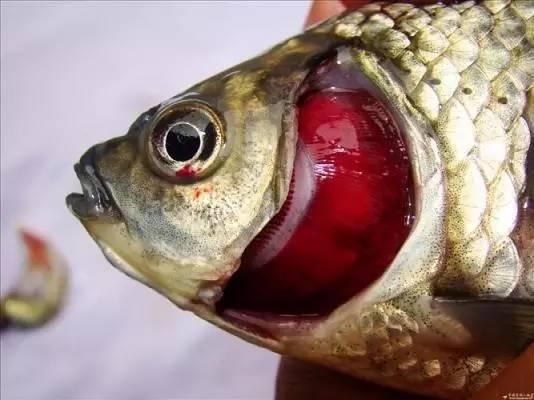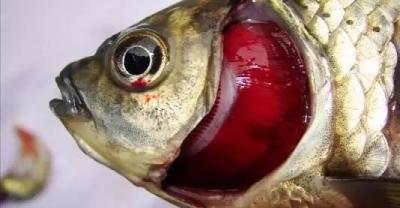Suggestions on the treatment of large red gills of farmed fish
Fish big class
An unwalled fishery university
◆◆◆
one
The pathogen, symptom, epidemic situation and diagnosis of red Gill disease
01
Pathogen
At present, the pathogen of the big red Gill has not been determined, many views think that it is caused by Aeromonas hydrophila or Vibrio, but through the artificial challenge experiment, the symptoms of the big red Gill can not be repeated all the time. In some cases of big red gills, parasites and viruses were not found. It is speculated that the symptoms of big red gills in crucian carp may be mainly caused by bacteria such as Aeromonas hydrophila, Vibrio and bad culture environment. Drugs stimulate the gills and other external factors, which can be effectively treated by antimicrobials.
02
Symptom
In the early stage, there were no obvious symptoms, and the diseased fish often swam under the surface of the pool in the middle and later stage, especially the downwind mouth, where the head and back of the diseased fish were blackened by the naked eye, commonly known as "blackhead", Gill edema and bleeding showed bright red, while normal fish gills showed dark red.
Dissecting diseased fish, the most obvious symptoms are spotted bleeding in the liver, showing blotchy or white in severe cases, sometimes accompanied by enlarged and blackened gallbladder, and yellowish ascites (jelly-like after air contact). The diseased fish floated weakly on the surface of the water and around the pond, especially in the shelter. After death, most of the diseased fish had intact body surface, a few had bleeding at the base of the fin and body surface, and the caudal fin and the ends of each fin turned white. Due to the edema of the gills of Carassius auratus, it is bright red, so the farmers call it the big red Gill. Sometimes it is often associated with parasitic diseases.

03
Popular situation
The disease of "big red Gill" has been becoming more and more popular since it occurred in Yancheng and other breeding areas of Jiangsu Province in 2007. The peak of "big red Gill" disease occurs from May to July, and the water temperature is in the range of 20 ℃-26 ℃. It is mainly harmful to crucian carp with body weight less than 250g.
04
Diagnosis
In the process of diagnosis, attention should be paid to the distinction between Carassius auratus red Gill and Gill hemorrhagic disease.
The Gill filaments of the diseased fish with big red Gill disease are particularly bright red (such as the red flesh of watermelon), which will restore the original color once put into the water basin, which is different from the symptoms of diseased fish in the past. The phenomenon of black body color of diseased fish is more. There was no red spot in the operculum of the dead fish, the body surface of the dead fish was relatively normal, the swim bladder of the diseased fish showed diffuse bleeding, and the food intake decreased when the disease occurred.
The swim bladder of Gill haemorrhage is punctate bleeding. The phenomenon of blackening of body color is less, and the food intake of diseased fish is hyperactive. There are erythema formed by blood accumulation on one side of the operculum and punctate hyperemia at the base of the eyeball and mandible and pectoral fin.

Photo source: China Fisheries Channel
The difference between Gill hemorrhagic disease of big red Gill fish (2 on the left and 2 on the right)
two
Inducement of big red Gill disease
The main causes of red Gill and Gill bleeding are:
01
Fish seed quality degradation
Red Gill disease is also directly related to the germplasm degradation of crucian carp. in the main culture areas of crucian carp, the coverage rate of improved seedlings is low, the threshold of aquatic breeding is low, and inbreeding exists in many non-standard seedling farms in the process of breeding. as a result, the germplasm of crucian carp seedlings degraded, the disease resistance decreased and the incidence increased.
02
Aggravation of water environment pollution and deterioration of pond bottom quality
In the actual production, it is found that the incidence of culture pond mouth with good water quality management is significantly lower than that of pond mouth with poor water quality management. Reasonable disinfection, water transfer and management measures before the high incidence of diseases in May will play a key role in the prevention and control of diseases in crucian carp culture throughout the year.
03
Unreasonable use of pesticides and antibiotics
In the areas where Carassius auratus red Gill disease is serious, there is widespread non-standard use of drugs in the process of culture, and a large number of non-drugs with unknown ingredients act as therapeutic drugs in production. Many farmers are misled by some fish drug sellers. Large doses of irritating insecticides and disinfectants such as heavy metals, ammonium, organophosphorus and pyrethroids are selected to kill insects and disinfect frequently, antibiotics (such as sulfonamides) The unreasonable use of doxycycline hydrochloride (doxycycline hydrochloride, etc.) causes damage to the liver, which is the drug metabolic organ of fish, and leads to the decline of the physique and immunity of fish.
04
Unreasonable feeding of farmers, etc.
Driven by economic interests, many farmers have to increase the amount of feed to let the fish reach the market specifications as soon as possible, and the psychology of sales is that haste makes waste, and excessive intake of nutrients causes excessive metabolic pressure in the fish, which exceeds the nutritional needs of the fish, thus translating into the accumulation of fat in the liver and mesentery, resulting in a decline in fish's resistance to disease.
three
Prevention and treatment of Big Red Gill Disease
01
Prevention
1. Reasonable killing of parasites. In the process of breeding, it is recommended to regularly use Chinese herbal medicine to prevent parasites, do not recommend the use of irritating pesticides, can not kill insects, it is necessary to judge whether the number of parasites is pathogenic or not, and prevent parasites from the improvement of the overall culture environment.
2. When the peak period of feeding comes, the management of water quality and sediment should be strengthened, and photosynthetic bacteria, bacillus, compound microbial preparation and potassium persulfate should be used regularly to improve the bottom quality so as to maintain a good culture environment.
3. Immune enhancers (VC for aquatic products, Astragalus polysaccharides, etc.) are regularly used in the high incidence season to improve the physique and resistance of fish.
4. for the selection of seedlings, it is suggested to choose the high-quality seedlings of the standard good seed farm, and not to choose the inferior seedlings cheaply, which leads to the decline of the growth rate and disease resistance, and the loss outweighs the gain.
02
Treatment
After the onset of the disease, it is necessary to reduce the stress of adverse environmental factors on farmed fish. Crucian carp has red Gill disease. Due to the existence of Gill lesions, the Gill respiratory function is damaged to a certain extent. In the process of treatment, sufficient dissolved oxygen in the pond should be ensured to reduce the fish stress reaction caused by low dissolved oxygen in water.
When the disease occurs, the water quality is detected first, and the pond mouth with big red Gill disease often has poor water quality. in case of poor water quality, the treatment should start with stopping feeding, resisting stress and improving water quality to improve the living environment of diseased fish.
Secondly, check whether there are rotifers, ring worms and other parasites on the gills, if there is timely treatment; finally, use povidone iodine, methionine iodine and other mild disinfectants for external use, combined with antibiotics and detoxification, repair physique and immunity of Chinese herbal medicine and immune enhancers for internal administration, before the use of antibiotics, it is best to carry out drug sensitivity test, so that the treatment effect will be better.
[proposed proposal]
1. If the water quality of the culture pond is poor, it is recommended to stop feeding for 2 days and use Sanbao high stable VC (250g / mu m) or sprinkle ginger (300g / mu m) + organic acid (500ml / mu m) into the whole pond in the morning. Use zeolite powder (5-10 kg / mu) or argon nitrate (sodium lignosulfonate, 250 g-500 g / mu) in the afternoon. (M) treatment of ammonia nitrogen and nitrite in aquaculture water. Turn on the aerator in the pond and sprinkle the whole pond with a fixed oxygen tablet (calcium peroxide, 2 packets of 1 mu) before nightfall. For 2 consecutive days.
2. Gill filaments are examined under microscope. If the number of parasites is enough to cause disease, the parasites above the gills should be treated in time, otherwise there is no need to deal with them.
3. If the water quality is not a big problem and there are no parasites in the gills, you can directly carry out the third step, disinfecting the water with povidone iodine (250-500 ml / mu) or Sanbao methionine iodine (4 mu per bottle) in the morning. In the afternoon, sprinkle ginger for anti-stress treatment. For 2 consecutive days, the pond is fully aerated, and the whole pond is sprinkled with fixed oxygen tablets (calcium peroxide, 2 packets and 1 mu) before night. For 2 consecutive days.
At the same time, reduce the amount of bait taken internally, and the amount of feed fed when taking the bait (is the normal amount of 1max 3pm 1pm 2). The recommended scheme for internal administration is as follows:
(1) 2 packets of florfenicol (10% florfenicol) or 100 grams of enrofloxacin (10% enrofloxacin) 100 grams + fragrant grass Sanhuang powder or Banhuang powder (1 pack) + aquatic special vitamin C (20 grams) or astragalus polysaccharides immune herbs 1 package + Kunhong vitamin K3 (1 package) for 5-7 days.
(2) compound sulfamethoxazole powder (aquatic use) 400g + Fangcao Sanhuang powder or Banhuang powder (1 pack) + aquatic special vitamin C (20g) or astragalus polysaccharide immune grass 1 pack + Kunhong vitamin K3 (1 pack) 10 kg, continuous feeding for 5-7 days, the first dosage of sulfonamides must be doubled.
Before the use of antibiotics, it is best to carry out drug sensitivity test, so that targeted, the treatment effect will be better.
4. matters needing attention in the process of treatment.
(1) do not use irritating drugs, such as chlorine preparations and insecticides. Iodine preparation has good effect and little irritation, so it is the first choice.
(2) try not to have irritating movements such as changing water and moving nets.
(3) the sick and dead fish must be fished out in time, and the net gear for fishing dead fish had better be dedicated to the pool to prevent the spread of pathogens.
- Prev

Popular science: general knowledge of ammonia nitrogen degradation in aquaculture water
Aquaculture friends may know that it is important to control the concentration of ammonia nitrogen in aquaculture water. Therefore, how to effectively control ammonia nitrogen and degrade ammonia nitrogen has become each.
- Next

Breeding crayfish is indispensable to these aquatic plants.
Crayfish culture is very hot, all want to dry, lobster said I am in crayfish farming "pilgrimage" Qianjiang, crayfish to raise good, water grass is not.
Related
- On the eggshell is a badge full of pride. British Poultry Egg Market and Consumer observation
- British study: 72% of Britons are willing to buy native eggs raised by insects
- Guidelines for friendly egg production revised the increase of space in chicken sheds can not be forced to change feathers and lay eggs.
- Risk of delay in customs clearance Australia suspends lobster exports to China
- Pig semen-the Vector of virus Transmission (4)
- Pig semen-the Vector of virus Transmission (3)
- Five common causes of difficult control of classical swine fever in clinic and their countermeasures
- Foot-and-mouth disease is the most effective way to prevent it!
- PED is the number one killer of piglets and has to be guarded against in autumn and winter.
- What is "yellow fat pig"? Have you ever heard the pig collector talk about "yellow fat pig"?

